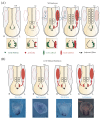The Role of Cerl2 in the Establishment of Left-Right Asymmetries during Axis Formation and Heart Development
- PMID: 29367552
- PMCID: PMC5753124
- DOI: 10.3390/jcdd4040023
The Role of Cerl2 in the Establishment of Left-Right Asymmetries during Axis Formation and Heart Development
Abstract
The formation of the asymmetric left-right (LR) body axis is one of the fundamental aspects of vertebrate embryonic development, and one still raising passionate discussions among scientists. Although the conserved role of nodal is unquestionable in this process, several of the details around this signaling cascade are still unanswered. To further understand this mechanism, we have been studying Cerberus-like 2 (Cerl2), an inhibitor of Nodal, and its role in the generation of asymmetries in the early vertebrate embryo. The absence of Cerl2 results in a wide spectrum of malformations commonly known as heterotaxia, which comprises defects in either global organ position (e.g., situs inversus totalis), reversed orientation of at least one organ (e.g., situs ambiguus), and mirror images of usually asymmetric paired organs (e.g., left or right isomerisms of the lungs). Moreover, these laterality defects are frequently associated with congenital heart diseases (e.g., transposition of the great arteries, or atrioventricular septal defects). Here, reviewing the knowledge on the establishment of LR asymmetry in mouse embryos, the emerging conclusion is that as necessary as is the activation of the Nodal signaling cascade, the tight control that Cerl2-mediates on Nodal signaling is equally important, and that generates a further regionalized LR genetic program in the proper time and space.
Keywords: Cerl2; LR-asymmetry; Nodal signaling; congenital heart diseases.
Conflict of interest statement
The authors declare no conflict of interest.
Figures



References
Publication types
LinkOut - more resources
Full Text Sources
Other Literature Sources

